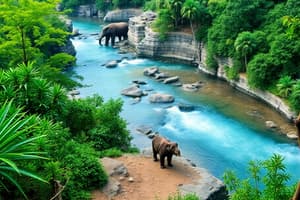Podcast
Questions and Answers
Which characteristic of tourism primarily involves the movement of people to destinations away from their usual place of residence?
Which characteristic of tourism primarily involves the movement of people to destinations away from their usual place of residence?
- Hospitality services
- Cultural exchange
- Recreational activity
- Travel (correct)
Which era of tourism is marked by the rise of international travel for leisure purposes?
Which era of tourism is marked by the rise of international travel for leisure purposes?
- The Post-World War II Era (correct)
- The Industrial Era
- The Ancient Era
- The Digital Era
What is one of the significant economic impacts of tourism on a destination's gross domestic product (GDP)?
What is one of the significant economic impacts of tourism on a destination's gross domestic product (GDP)?
- Increased production of local goods
- Decreased spending in local economies
- Reduction in local job opportunities
- Increased foreign investment (correct)
What is a potential negative impact of tourism as observed in Maya Bay?
What is a potential negative impact of tourism as observed in Maya Bay?
Which type of tourism is characterized by travel to remote areas and a focus on adventure and nature?
Which type of tourism is characterized by travel to remote areas and a focus on adventure and nature?
Flashcards are hidden until you start studying
Study Notes
Characteristics of Tourism
- Tourism involves the temporary movement of people to destinations outside their usual environment for leisure, business, or other purposes.
- Key characteristics include seasonality, diversity, and the need for hospitality services.
- It is an experience-based industry, heavily reliant on personal interactions and service quality.
History/Eras of Tourism
- Early forms of tourism can be traced back to ancient civilizations where travel was for trade, pilgrimage, or exploration.
- The Grand Tour in the 18th century marked a shift towards leisure travel among the elite in Europe.
- The advent of the railway and steamship in the 19th century made travel accessible to the middle class, leading to modern tourism.
Types of Tourism
- Types include adventure, cultural, eco, medical, and mass tourism, each catering to different interests and demographics.
- Sustainable tourism emphasizes minimizing environmental impact and preserving cultural heritage.
- Dark tourism involves travel to sites associated with death, suffering, or disaster.
Distribution of Tourist Locations
- Major tourist hotspots are often found in cities or regions with rich cultural, historical, or natural attractions.
- Geographic distribution is influenced by factors like climate, accessibility, safety, and existing infrastructure.
- Issues like overcrowding and environmental degradation can arise in popular destinations.
Economic Multiplier Effect
- Tourism generates income and employment opportunities by stimulating demand in related sectors like hospitality, transportation, and retail.
- Every dollar spent by a tourist typically generates additional economic activity, benefiting local communities and economies.
- The multiplier effect can enhance local infrastructure and public services through increased tax revenues.
Tourism & GDP
- The tourism industry contributes significantly to national GDPs, with some countries relying heavily on tourism for economic stability.
- Direct contributions to GDP include spending on accommodation, food, and transport, while indirect contributions stem from investments and services.
- Sustainable management of tourism is vital to maximize long-term economic benefits.
Impacts of Tourism (Maya Bay)
- Maya Bay faced environmental degradation due to mass tourism, leading to damage to coral reefs and ecosystems.
- In response, the bay was closed to tourists for rehabilitation, highlighting the need for sustainable practices.
- The situation exemplifies the balance required between tourism development and environmental preservation.
Changes in Landscapes (Vang Vieng)
- Vang Vieng transformed from a quiet town to a major tourist destination, impacting local culture and the environment.
- Increased visitor numbers have led to deforestation, water pollution, and loss of traditional lifestyles.
- Efforts are underway to promote responsible tourism and restore the region's natural beauty.
Independent Case Study - Impacts/Responses (Bali, Hawaii, Fiji, Nepal, or Byron Bay)
- Each case presents unique challenges like environmental impacts, cultural preservation, and community displacement.
- Strategies implemented include tourism caps, promoting sustainable practices, and community involvement in tourism planning.
- Success stories highlight the importance of balancing economic interests with environmental conservation and local culture.
Studying That Suits You
Use AI to generate personalized quizzes and flashcards to suit your learning preferences.




